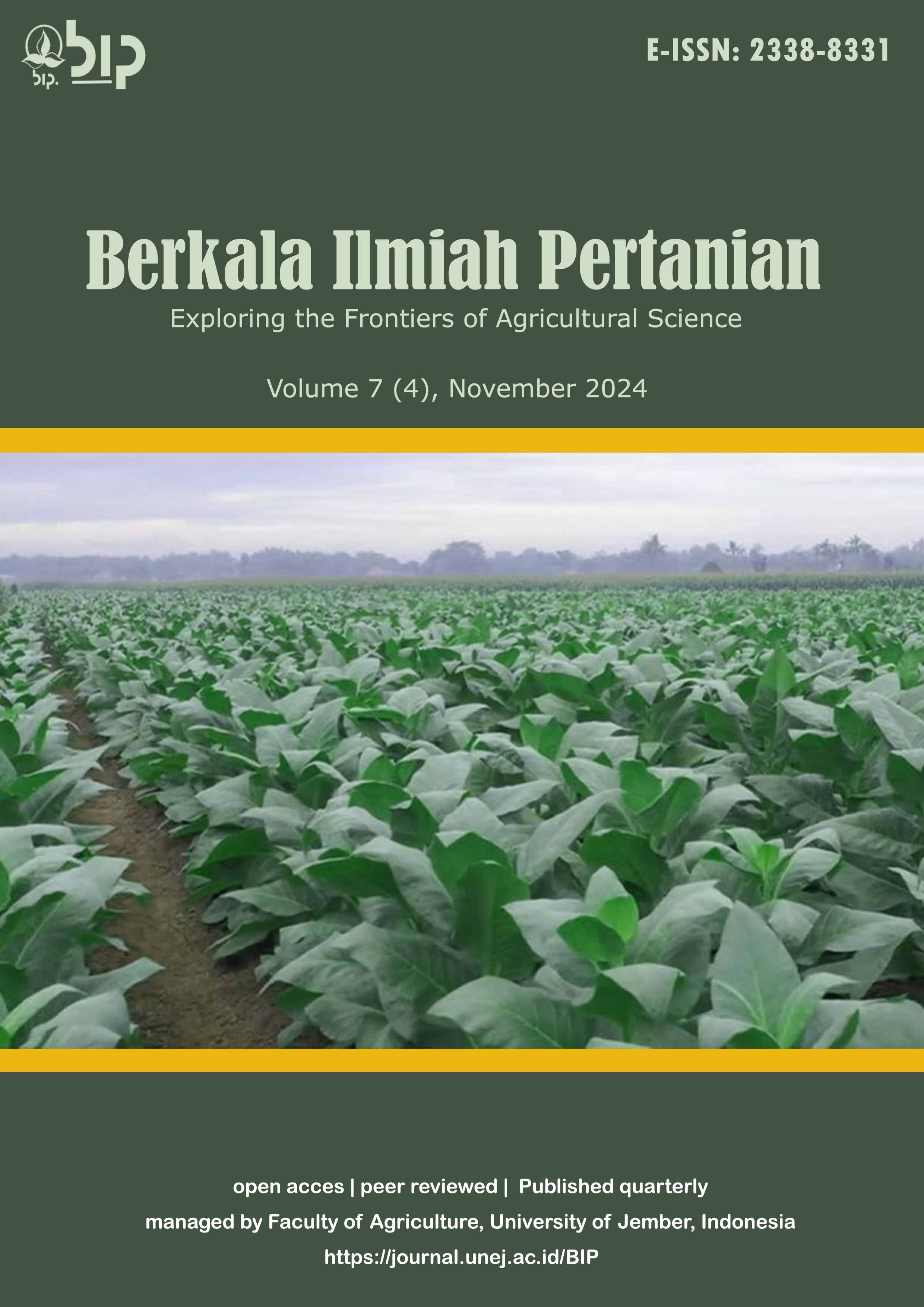Optimalisasi Slurry dan Baglog Terhadap Peningkatan Kualitas Bahan Baku Kompos
DOI:
https://doi.org/10.19184/bip.v7i4.53686Abstract
Slurry can potentially be used as a basic material in composting. This is due to the high organic matter and nitrogen level of the slurry. Slurry has a low C/N ratio of 7.4, which might cause nitrogen loss via NH3 and NO2. Slurry handling requires management, such as the addition of baglog raw ingredients. Baglog is a waste media in mushroom production. Baglog has a C:N ratio of 35.21. Compost raw materials with a high C/N ratio smell because the primary bacteria are not present. As a result, composting raw materials with the lowest C/N ratio must be combined with materials with a high C/N ratio. The purpose of this research is to determine the combination of compost raw materials, such as baglog and slurry, to produce compost that satisfies quality standards. The composting research experiment consists of six treatments, including K1 (25 liters of slurry + 25 kg of baglog + 0 ml of decomposer), K2 (25 liters of slurry + 25 kg of baglog + 3 ml/1000 mL of decomposer), K3 (30 liters of slurry + 20 kg of baglog + 3 ml/1000 mL of decomposer), K4 (40 liters of slurry + 30 kg of baglog + 3 ml/1000 mL of decomposer), K5 (50 liters of slurry + 25 kg of baglog + 3 ml/1000 mL of decomposer), and K6 (25 liters of slurry + 50 kg of baglog + 3 ml/1000 mL of decomposer). The compost quality standards of Minister of Agriculture Regulation No. 01 (2019) are satisfied by treatments K1 until K4. Application K2 (slurry 25 liters + baglog 25 kg + decomposer 3 ml/1000 mL) a higher nitrogen value compared to other treatments.
Downloads
References
Al-Amin, M., Rahman, MM., Islam, SMA., Dhakal, H., Khan, MRI., Amin, MR., and Kabir, AKMA. 2020. Effect of bulking materials over the composting of bio-slurry. Bangladesh Journal of Animal Science. 49 (2): 142-150. https://doi.org/10.3329/bjas.v49i2.53224
Awasthi M.K., Wang M., Chen Q., Wang J., Zhao X., Ren D.S., Li, S.K, Awasthi, F., Shen, R.L and Zhang Z. 2017. Heterogeneity of Biochar Amendment to Improve the Carbon and Nitrogen Sequestration Through Reduce the Greenhouse Gases Emissions During Sewage Sludge Composting. Bioresource Technology. 224, 428–438. https://doi.org/10.1016/j.biortech.2016.11.014
Biederman, L. A and W. S. Harpole. 2013. Biochar and Its Effects on Plant Productivity and Nutrient Cycling : a Meta- Analysis. GCB Bioenergy. 5: 202-214. https://doi.org/10.1111/gcbb.12037
Chen, L., M. D. H. Marti, A. Moore and C. Falen. 2011. The Composting Process: Dairy Compost Production and Use in Idaho CIS 1179, University of Idaho. Pp 1-5.
Chen, Z., S. Zhang, Q. Wen and J. Zheng. 2015. Effect of Aeration Rate On Composting of Penicillin Mycelial Dreg. Journal of Environmental Sciences. 37 : 172-178. https://doi.org/10.1016/j.jes.2015.03.020
Cáceres, R., K. Malińska and O. Marfá. 2018. Nitrification Within Composting. Journal Waste Management. 72: 119-137. https://doi.org/10.1016/j.wasman.2017.10.049
Di, Q L and M. Lin. 2014. Effect of Biogas Manure on Yield and Quality of Strawberry in Greenhouse. Journal of Henan Agricultural Sciences. 43(3):121-123.
Fang, W., P. Zhang, X. Gou, H. Zhang, Y. Wu, J. Ye and G. Zeng. 2016. Volatile Fatty Acid Production From Spent Mushroom Compost: Effect Of Total Solid Content. International Biodeterioration and Biodegradation. 113:217–221. https://doi.org/10.1016/j.ibiod.2016.03.025
Harmiansyah., Pratama, R. D., Afisna, L. P., Syaukani, M dan Efendi, R. 2022. Karakteristik Sisa Slurry pada Produksi Biogas Berbahan Kotoran Sapi. Jurnal Material dan Proses Manufaktur. 6(2):46-53. https://doi.org/10.18196/jmpm.v6i2.16175
Hu W., Zheng G., Fang D., Cui C., Liang J and Zhou L. 2015. Bioleached Sludge Composting Drastically Reducing Ammonia Volatilization As Well As Decreasing Bulking Agent Dosage And Improving Compost Quality: A Case Study. Waste Management. 44, 55-62. https://doi.org/10.1016/j.wasman.2015.07.023
Kadir, A. A., N. W. Azhari and S. N. Jmaludin. 2016. An Overview of Organic Waste in Composting. EDP Sciences. 47-53. DOI: 10.1051/matecconf/20164705025
Kementrian Pertanian. 2019. Peraturan Menteri Pertanian Tentang Pupuk Organik, Pupuk Hayati, dan Pembenah Tanah Nomor 01. Indonesia
Kumar, S., Malav, LC., Malav, MK and Khan, SA. 2015. Biogas Slurry: Source of Nutrients for Eco- Friendly Agriculture. Journal of Extensiv Research. 2,42- 46.
Li, Y., W. Li, C. Wu and K. Wang. 2013. New insights into the interactions between carbon dioxide and ammonia emissions during sewage sludge composting. Bioresource Technology. 136: 385–393. https://doi.org/10.1016/j.biortech.2013.03.061
Meng, L., W. Li, S. Zhang, C. Wu and L. Lv. 2017. Feasibility of Co- Composting of Sewage Sludge, Spent Mushroom Substrate and Wheat Straw. Bioresource Technoogy. 226: 39-45. https://doi.org/1 0.1016/j.biortech.2016.11.054
Meng X, Dai J, Zhang Y, Wang X, Zhu W, Yuan X, Yuan, H and Cui Z. 2018. Composted Biogas Residue and Spent Mushroom Substrate as a Growth. Medium For Tomato and Pepper Seedlings. Journal of Environmental Management. 216, 62-69. https://doi.org/10.1016/j.jenvman.2017.09.056
Onwonsi, C. O., Igbokwe, V.C., Odimba, J. N., Eke, I. E., Nwankwoala, M.O., Iroh, I. N. and Ezeeogu, L. I. 2017. Composting Technology In Waste Stabilization : On The Methods Challenges And Future Prospects. Journal of Environmental Mangement. 190 :140-157. https://doi.org/10.1016/j.jenvman.2016.12.051
Sánchez, O.J., D. A. Ospina and S. Montoya. 2017. Compost Supplementation With Nutrients and Microorganisms In Composting Process. Journal Waste Management. 69 : 136-153. https://doi.org/10.1016/j.wasman.2017.08.012
Setianingsih., T. E., R. Suntari and C. Prayogo. 2021. Utilization of slurry and mushroom baglog to improve growth and yield on strawberry on degraded volcanic soils. Journal of Degraded and Mining Land Management. 8 (3): 2743-2750. https://doi.org/10.15243/jdmlm.2021.083.2769
Zakarya, I. A, S. N B. Khatib and N. M. Ramzi. 2018. Effect of pH, Temperature and Moisture Contrnt During Composting of Rice Straw Burning at Differnet Temperature With Food Waste and Effective Microorganisms. Journal Cenviron. 34 (10):1-8. https://doi.org/10.1051/e3sconf/20183402019
Zhang, L and X. Sun. 2014. Changes in physical, chemical, and microbiological properties during the two-stage co-composting of green waste with spent mushroom compost and biochar. Bioresour Technology. 171: 274-284. https://doi.org/10.1016/j.biortech.2014.08.079
Zhang, J., G. Chen, H. Sun, S. Zhou and G. Zou. 2016. Straw Biochar Hastens Organic Matter Degredation and Produces Nutrient Rich Compost. Bioresorce Tecnology. 200: 876-883. https://doi.org/10.1016/j.biortech.2015.11.016
Downloads
Published
Issue
Section
License

This work is licensed under a Creative Commons Attribution-NonCommercial 4.0 International License.
Authors who publish with this journal agree to the following terms:
1.Authors retain copyright and grant the journal right of first publication with the work simultaneously licensed under a Creative Commons Attribution-NonCommercial 4.0 International License that allows others to share the work with an acknowledgement of the work's authorship and initial publication in this journal.
2.Authors are able to enter into separate, additional contractual arrangements for the non-exclusive distribution of the journal's published version of the work (e.g., post it to an institutional repository or publish it in a book), with an acknowledgement of its initial publication in this journal.
3.Authors are permitted and encouraged to post their work online (e.g., in institutional repositories or on their website) prior to and during the submission process, as it can lead to productive exchanges, as well as earlier and greater citation of published work (See The Effect of Open Access).




















